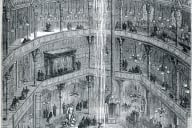You have /5 articles left.
Sign up for a free account or log in.
Finding himself in prison following the beer-hall fiasco in Munich in 1923, Adolf Hitler had time to put his thoughts about politics and destiny into order, at least as much as that was possible. The United States was part of his grand vision, and not as someplace to conquer.
“The racially pure and still unmixed German has risen to become master of the American continent,” he wrote in Mein Kampf, “and he will remain the master, as long as he does not fall victim to racial pollution.” He was encouraged on the latter score by what he had learned of American immigration policy. With its stated preference for Northern Europeans, its restrictions on those from Southern and Eastern Europe, and its outright exclusion of everyone else, the Immigration Act of 1924 impressed Hitler as exemplary. It manifested, “at least in tentative first steps,” what he and his associates saw as “the characteristic völkisch conception of the state,” as defined in some detail by the Nazi Party Program of 1920.
Revulsion is an understandable response to this little traipse through the ideological sewer, but it is wholly inadequate for assessing the full measure of the facts or their implications. The admiration for American immigration policy expressed in Mein Kampf was not a passing thought on the day’s news (Hitler had been in prison for about two months when Calvin Coolidge signed the act into law) nor a one-off remark. Its place in the full context of Nazi theory and practice comes into view in Hitler’s American Model: The United States and the Making of Nazi Race Law (Princeton University Press) by James Q. Whitman, a professor of comparative and foreign law at Yale Law School.
Many people will take the very title as an affront. But it’s the historical reality the book discloses that proves much harder to digest. The author does not seem prone to sensationalism. The argument is made in two succinct, cogent and copiously documented chapters, prefaced and followed with remarks that remain within the cooler temperatures of expressed opinion (e.g.: “American contract law, for example, is, in my opinion, exemplary in its innovativeness”).
Hitler’s American Model is scholarship and not an editorial traveling incognito. Its pages contain many really offensive statements about American history and its social legacy. But those statements are all from primary sources -- statements about America, made by Nazis, usually in the form of compliments.
“The most important event in the history of the states of the Second Millennium -- up until the [First World] War -- was the founding of the United States of America,” wrote a Nazi historian in 1934. “The struggle of the Aryans for world domination thereby received its strongest prop.” Another German author developed the point two years later, saying that “a conscious unity of the white race would never have emerged” without American leadership on the global stage following the war.
Examples could be multiplied. The idea of the United States as a sort of alt-Reich was a Nazi commonplace, at least in the regime’s early years. But it was not just a matter of following Hitler’s lead. The white-supremacist and eugenicist writings of Madison Grant and Lothrop Stoddard -- among the best-selling American authors of a 100 years ago -- circulated in translation in the milieu that spawned Hitler. (I don’t recall Hannah Arendt mentioning Grant or Stoddard in Origins of Totalitarianism, oddly enough.) A popular Nazi magazine praised lynching as “the natural resistance of the Volk to an alien race that is attempting to gain the upper hand.” European visitors noted the similarity between the Ku Klux Klan and fascist paramilitary groups like the Brownshirts, and they compared the post-Reconstruction order in the South to the Nazi system.
But the journalistic analogies and propaganda talking points of the day, while blatant enough, don’t convey the depth of American influence on Nazi race law. The claim of influence runs against the current of much recent scholarship arguing that Nazi references to the Jim Crow system were “few and fleeting” and that American segregation laws had little or no impact on the Nuremberg Laws. (At the Nuremberg rally of 1935, the Nazis proclaimed citizenship limited to those “of German blood, or racially related blood” and outlawed marriage or sexual relations between Jews and German citizens.)
While the Nazis did call attention to segregation in the United States -- so the argument goes -- it was to deflect criticism of German policy. The error here, as Whitman sees it, comes from treating the U.S. Supreme Court ruling in Plessy v. Ferguson as the primary or quintessential legal component of racial oppression in the United States, and presumably the one Nazi jurists would have looked to in reshaping German policy. But, according to Whitman, “American race law” in the 19th and much of the 20th century:
sprawled over a wide range of technically distinct legal areas … [including] Indian law, anti-Chinese and -Japanese legislation, and disabilities in civil procedure and election law …. Anti-miscegenation laws on the state level featured especially prominently … [as] did immigration and naturalization law on the federal level ….
Even before the outbreak of World War I, German scholars were fascinated by this teeming mass of American racist law -- with a particular interest in what one of them identified as a new category of “subjects without citizenship rights” (or second-class citizens, to put it another way) defined by race or country of ancestry. By the 1930s, the anti-miscegenation laws in most American states were another topic of great concern. While many countries regarded interracial marriage as undesirable, Nazi jurists “had a hard time uncovering non-American examples” of statutes prohibiting it.
A stenographic transcript from 1934 provides Whitman’s most impressive evidence of how closely Nazi lawyers and functionaries had studied American racial jurisprudence. A meeting of the Commission on Criminal Law Reform “involved repeated and detailed discussion of the American example, from its very opening moments,” Whitman writes, including debate between Nazi radicals and what we’d have to call, by default, Nazi moderates.
The moderates argued that legal tradition required consistency. Any new statute forbidding mixed-race marriages had to be constructed in accord with the one existing precedent for treating a marriage as criminal: the law against bigamy. This would have been a bit of a stretch, and the moderates preferred letting the propaganda experts discourage interracial romance rather than making it a police matter.
The radicals were working from a different conceptual tool kit. Juristic tradition counted for less than what Hitler had called the “völkisch conception of the state,” which demanded Aryan supremacy and racial purity. It made more sense to them to follow an example that had been tried and tested. One of the hard-core Nazis on the commission knew where to turn:
Now as far as the delineation of the race concept goes, it is interesting to take a look at the list of American states. Thirty of the states of the union have race legislation, which, it seems clear to me, is crafted from the point of view of race protection. … I believe that apart from the desire to exclude if possible a foreign political influence that is becoming too powerful, which I can imagine is the case with regard to the Japanese, this is all from the point of race protection.
The lawyers whom Whitman identifies as Nazi radicals seemed to appreciate how indifferent the American states were to German standards of rigor. True, the U.S. laws showed a lamentable indifference to Jews and Gentiles marrying. But otherwise they were as racist as anything the führer could want. “The image of America as seen through Nazi eyes in the early 1930s is not the image we cherish,” Whitman writes, “but it is hardly unrecognizable.”




